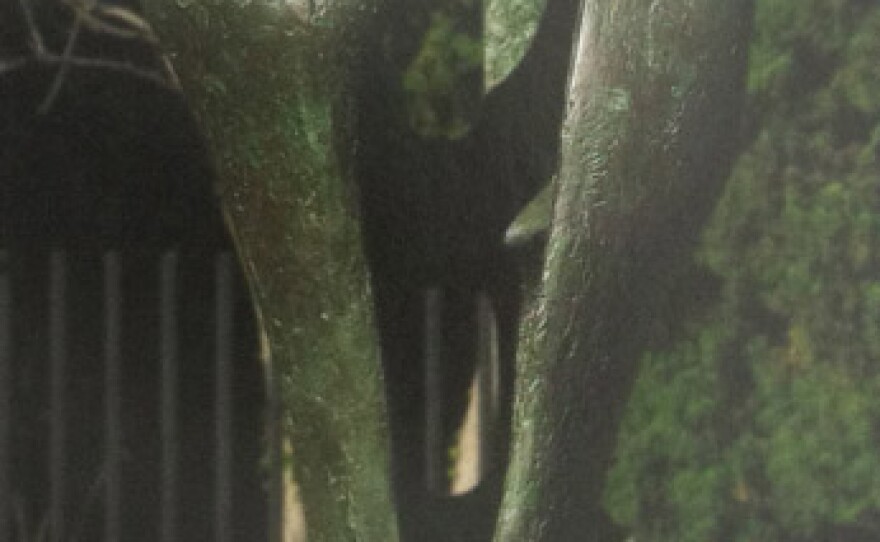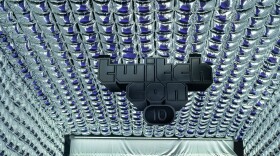There’s a white bust of Albert Einstein on a table in Cosmo Wenman’s studio. The Vista resident picks it up with ease. It’s clearly not made of marble. In fact, the bust weighs a mere 2 lbs. Even more jarring, Wenman removes the face from the bust to reveal a hollow interior. The statue has Einstein’s wild locks and all-to familiar visage, but the whole thing is composed of plastic. It was made with Wenman’s 3D printer.

3D printers are still relatively new to the average consumer. They cost anywhere between $1,000 and $5,000 for consumer-grade models. Entrepreneurs, inventors, health professionals, artists and scientists are all exploring the technology’s potential.
Wenman is using his 3D printer to make copies of famous antiquities and works of art.
Case in point: an impressive duo of horse heads on a credenza in Wenman’s dining room. They are copies of a piece called “Head of a Horse of Selene.” The original is in the British Museum; before that it was on the Parthenon in Athens, Greece (part of the now infamous Elgin Marbles). Wenman’s copies are life-size. They have a bronze and brass patina finish. The original is marble. Wenman printed 29 separate pieces of plastic and glued them together to form each horse head.
He recently showed one at the massive Consumer Electronics Show in Las Vegas. At one point he noticed a man putting his hands all over the horse head, exploring it.
“And I’m thinking oh my god, I hope he doesn’t break it or something,” said Wenman. “When the guy turned around, I realized he was blind.”
Wenman believes if more 3D copies of important artworks become available, the public will find all kinds of uses for them, just like the blind man did. “That person would never have been able to explore the original marble in the British museum. That just would not happen,” he added.
Wenman says 3D copies of ancient artworks offer plenty of educational opportunities. Kids can have copies of fossil skulls in the classroom. Professors can use 3D copies in art history classes.
The average person can create new works of art by changing and remixing ancient works, similar to what happened in the music industry when artists started sampling older music in their songs. “It is now possible to mass digitize sculptural art. People will download what they want and love, and what they want other people to see,” explained Wenman. “Some people will remix them in interesting, novel ways.”
Wenman recognizes that some might find the whole process of making plastic copies of the world’s great sculptures distasteful. “There will be tastemakers and gatekeepers who will say this whole process lessens the importance or is an insult to the original or the original artist,” said Wenman. “I don’t find that particularly convincing. To me it’s about sharing the artwork and I’ll leave it to the people who have a stake in the other camp to make their case as to why that might be a bad thing.”
How The Technology Works

“So we’re making a miniature test print of Barbara Hepworth’s 1960 ‘Figure for Landscape,’ which I scanned at the San Diego Museum of Art,” Wenman explained as he turned on the 3D printer, which sounds like an old dot matrix printer.
Wenman’s 3D printer is about the size of a large microwave, without any sides. The printer puts down layer after layer of molten plastic to form the sculpture, kind of like an automated glue gun. The plastic is fed in string form from a spool hanging above the printer.
When the sculpture is done, it’s a tiny version of Hepworth’s abstract artwork from SDMA’s sculpture garden. The whole process took about 45 minutes.
In order to make a copy of an already existing sculpture, the 3D printer needs digital information about the analog object. Capturing the sculpture digitally can happen through photographs or scanning. Wenman has taken hundreds of photographs of select sculptures at US and European museums. He’s been known to spend hours snapping photos of every angle of a sculpture, which has raised a few security guards’ eyebrows. “They’re used to seeing enthusiastic photographers,” said Wenman. “I just look like a particularly nutty one.”
Those photographs are processed using specialized software that translates the information into a file the 3D printer can read. Once Wenman gets a virtual model he likes, he starts the actual printing process.
Wenman copies antiquities because those artists are long dead, so there is no copyright. “If I were his lawyer, I’d tell him that’s smart,” said Julie Samuels, a staff attorney at the Electronic Frontier Foundation who also holds the title “The Mark Cuban Chair to Eliminate Stupid Patents” (no joke). “If a piece is no longer covered by copyright then it belongs in what is called the public domain. That means it belongs to everybody,” said Samuels. Anyone can republish, distribute, or copy a work if it’s in the public domain. “Most artwork not considered modern art is already in the public domain,” Samuels added.
But in order to copy an antiquity, you need access to the art, and museums can still control that.
Consumer 3D Printing And Museums
Wenman’s growing archive of documented works for 3D printing puts him ahead of much of the museum world. “Many museums in the world have barely covered their collection with 2D photography,” said Tatjana Dzambazova, a senior project manager and technology whisperer (no joke, #2) at Autodesk, Inc. The San Francisco-based company designs software for 3D printing, as well as for other industries like architecture and entertainment.
Dzambazova says there are only a handful of museums capturing their collections for 3D digitization and printing.
The Smithsonian is one of them.
There are 137 million objects in the Smithsonian’s collection. Only 2% of that collection is on public view at any one time. 14 million pieces in the collection have been designated as a priority for digital scanning and capturing. Right now the process is laborious. Vince Rossi and Adam Metallo run the Smithsonian’s Digitization Program. They’re hoping to scale up and make the capturing process faster. “One day we could have a 7-axis robotic arm doing the work, capturing an item a day,” said Metallo by phone from Washington, DC.
The digital captures of the collection can be used in many ways. Some will be printed as 3D models for use in museums, classrooms and research. Rossi and Metallo recently used a 3D scan to help design a perfect cradle for a fragile object that needed to travel to another museum.
Wenman and open source advocates want institutions like the Smithsonian to make their 3D scans available to the public for download. Rossi says that’s on the horizon. “Right now I can’t say too much about how that information will be made available to the world but people should stay tuned,” said Rossi by phone.
This is new ground for museums. They have to figure out what information they can make available to anyone with a 3D printer. Rossi says even copies of original artifacts can have meaning and value, which gives museums a lot to consider. He offered one example. “We’ve done a number of 3D scans of objects that got repatriated to Native American communities,” Rossi explained. “We’re going to be very careful with those data sets. The objects themselves have huge religious significance.”
As institutions figure out how much information they’re willing to share, those using this technology - whether within a museum setting or at home – all agree on one thing: there’s unlimited potential. “There’s millennia of beautiful objects out there that can be digitized,” said Wenman.
Wenman says that while museums are important for preserving original artifacts, they aren’t always the best way to interact with art. “To me, I can look at that kind of setting and think this is actually a mausoleum,” said Wenman. “These things are entombed here and they need to be brought back to life.”
Wenman sees 3D scans and copies as a way to liberate the world’s art from the rarified space that is the modern day museum.






